
1 #成员修饰符 修饰符可以规定内部的字段、属性、方法等 是共有的成员,私有的成员 2 class Foo: 3 def __init__(self,name,age): 4 self.name=name 5 self.age=age #可以在外部直接访问 6 7 obj=Foo('Jack',22) 8 print(obj.name) 9 print(obj.age)
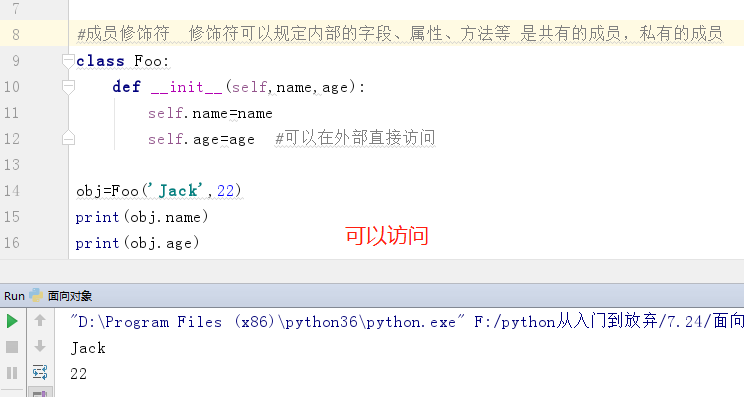
1 #成员修饰符 修饰符可以规定内部的字段、属性、方法等 是共有的成员,私有的成员 2 class Foo: 3 def __init__(self,name,age): 4 self.name=name 5 #self.age=age #可以在外部直接访问 6 self.__age=age #添加 __ 两个下划线,就变成私有字段,外部不能访问 7 obj=Foo('Jack',22) 8 print(obj.name) 9 print(obj.age)
运行结果:
"D:Program Files (x86)python36python.exe" F:/python从入门到放弃/7.24/面向对象.py Traceback (most recent call last): Jack File "F:/python从入门到放弃/7.24/面向对象.py", line 16, in <module> print(obj.age) AttributeError: 'Foo' object has no attribute 'age' Process finished with exit code 1
私有字段外部不能直接访问。可以通过内部的方法,间接访问
1 #成员修饰符 修饰符可以规定内部的字段、属性、方法等 是共有的成员,私有的成员 2 class Foo: 3 def __init__(self,name,age): 4 self.name=name 5 #self.age=age #可以在外部直接访问 6 self.__age=age #添加 __ 两个下划线,就变成私有字段,外部不能访问 7 def get_age(self): 8 return self.__age 9 obj=Foo('Jack',22) 10 print(obj.name) 11 print(obj.get_age())
运行结果:
"D:Program Files (x86)python36python.exe" F:/python从入门到放弃/7.24/面向对象.py Jack 22 Process finished with exit code 0

1 #成员修饰符 修饰符可以规定内部的字段、属性、方法等 是共有的成员,私有的成员 2 class Foo: 3 gender='男' #对于静态字段 4 def __init__(self,name,age): 5 self.name=name 6 #self.age=age #对于普通字段可以在外部直接访问 7 self.__age=age #添加 __ 两个下划线,就变成私有字段,外部不能访问 8 def get_age(self): 9 return self.__age 10 obj=Foo('Jack',22) 11 # print(obj.name) 12 # print(obj.get_age()) 13 print(obj.gender)

1 class Foo: 2 #gender='男' #对于静态字段 3 __gender = '男' 4 def __init__(self,name,age): 5 self.name=name 6 #self.age=age #对于普通字段可以在外部直接访问 7 self.__age=age #添加 __ 两个下划线,就变成私有字段,外部不能访问 8 def get_age(self): 9 return self.__age 10 def get_gender(self): 11 return Foo.__gender 12 obj=Foo('Jack',22) 13 # print(obj.name) 14 # print(obj.get_age()) 15 print(obj.get_gender())

1 class Foo: 2 __gender='男' 3 def __init__(self): 4 pass 5 6 # def get_gender(self): 7 # return Foo.__gender 8 9 @staticmethod 10 def get_gender(): 11 return Foo.__gender 12 # obj=Foo() 13 # print(obj.get_gender()) 14 print(Foo.get_gender())
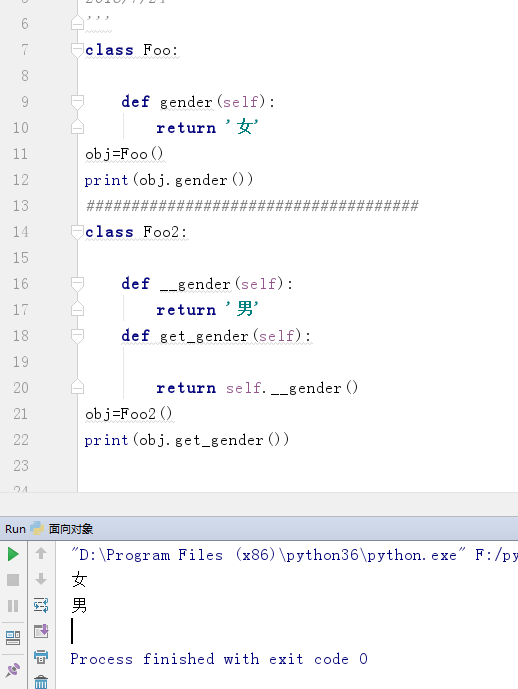

1 #案例 数据库账户 2 class Database: 3 __root="root" 4 __pwd='abc123' 5 __port='3306' 6 __dbname='ssoa' 7 # def __init__(self,pwd): 8 # pass 9 ###############只读模式######################## 10 def get_root(self): #只能访问,不能修改 可读 11 return self.__root 12 def get_port(self): 13 return self.__port 14 15 ###########读写模式 ################# 16 def get_pwd(self): #获取密码 17 return self.__pwd 18 def set_pwd(self,pwd): #修改密码 19 self.__pwd = pwd 20 21 db= Database() 22 print(db.get_pwd()) #调用密码 23 db.set_pwd('456') #修改密码 24 print(db.get_pwd())#调用密码

1 class ClassFather: 2 def __init__(self): 3 self.__age=23 4 self.score=90 5 6 class ClassSon(ClassFather): 7 def __init__(self,name): 8 self.name=name 9 self.__gender='男' 10 super().__init__() 11 12 def show(self): 13 print(self.name) 14 print(self.__gender) 15 print(self.score) 16 #print(self.__age)#私有字段只能在类的内部使用,不能被继承 17 18 s=ClassSon('李逵') 19 s.show()
类的特殊成员
__init__/__call__
1 class Foo: 2 def __init__(self): #对象后面加上() 自动执行 init 方法 3 print('init') 4 5 6 def __call__(self, *args, **kwargs): ##对象后面加() 自动执行 call 方法 7 print('call') 8 9 10 obj=Foo() 11 obj()
##相当于 Foo()()
__int__/__str__
1 class Foo: 2 def __init__(self): 3 pass 4 def __int__(self): 5 return 111 6 def __str__(self): 7 return 'string' 8 obj=Foo() 9 10 print(obj,' ',type(obj)) 11 12 #int ,对象,自动执行对象的__int__ 方法,并将返回值赋值给int对象 13 r=int(obj) 14 print(r) 15 #str ,对象,自动执行对象的__str__ 方法,并将返回值赋值给str对象 16 t=str(obj) 17 print(t)
运行结果:
"D:Program Files (x86)python36python.exe" F:/python从入门到放弃/7.24/面向对象.py string <class '__main__.Foo'> 111 string Process finished with exit code 0
在实际使用中,使用__str__() 方法的频率更大
例如:
1 class Foo: 2 def __init__(self,name,age): 3 self.name=name 4 self.age=age 5 6 obj=Foo('Jach',12) 7 print(obj)
运行结果:
"D:Program Files (x86)python36python.exe" F:/python从入门到放弃/7.24/面向对象.py <__main__.Foo object at 0x000000000222D1D0> Process finished with exit code 0
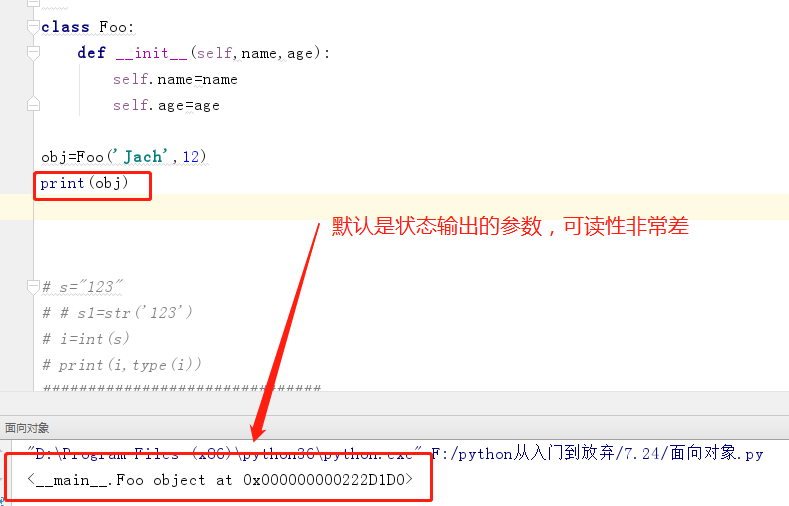
1 class Foo: 2 def __init__(self,name,age): 3 self.name=name 4 self.age=age 5 6 def __str__(self): #用于打印 7 return '%s----%s'%(self.name,self.age) 8 9 obj=Foo('Jach',12) 10 #如果直接调用对象打印出来,会默认直接调用 __str__ 方法 11 #内部先把'print(obj)'默认转换成>>>'print(str(obj))' 获取其返回值 12 print(obj)
运行结果:
"D:Program Files (x86)python36python.exe" F:/python从入门到放弃/7.24/面向对象.py Jach----12 Process finished with exit code 0
__add__
1 class Foo: 2 def __init__(self,name,age): 3 self.name=name 4 self.age=age 5 6 def __add__(self, other): 7 #self == obj('亚瑟',12) 8 #other==obj('后羿',23) 9 # return self.age+other.age 10 return Foo(self.name,other.age) 11 12 obj=Foo('亚瑟',12) 13 obj2=Foo('后羿',23) 14 15 r=obj+obj2 16 #两个相加时,会自动执行第一个对象的 __add__ 方法,并且把第二个参数当做参数传递进去 17 print(r,type(r)) 18 print(r.name) 19 print(r.age)
运行结果:
"D:Program Files (x86)python36python.exe" F:/python从入门到放弃/7.24/面向对象.py <__main__.Foo object at 0x00000000024BD4E0> <class '__main__.Foo'> 亚瑟 23 Process finished with exit code 0
构造方法 对象被创造的时候自动触发 __init__
析构方法 对象被销毁的时候自动触发 __del__
1 class Foo: 2 def __init__(self,name,age): 3 self.name=name 4 self.age=age 5 6 def __add__(self, other): 7 #self == obj('亚瑟',12) 8 #other==obj('后羿',23) 9 # return self.age+other.age 10 return Foo(self.name,other.age) 11 def __del__(self): 12 print('析构方法,对象销毁时,自动执行') 13 14 obj=Foo('亚瑟',12) 15 obj2=Foo('后羿',23) 16 17 r=obj+obj2 18 #两个相加时,会自动执行第一个对象的 __add__ 方法,并且把第二个参数当做参数传递进去 19 print(r,type(r)) 20 print(r.name) 21 print(r.age)
运行结果:
"D:Program Files (x86)python36python.exe" F:/python从入门到放弃/7.24/面向对象.py <__main__.Foo object at 0x0000000001EAD470> <class '__main__.Foo'> 亚瑟 23 析构方法,对象销毁时,自动执行 析构方法,对象销毁时,自动执行 析构方法,对象销毁时,自动执行 Process finished with exit code 0
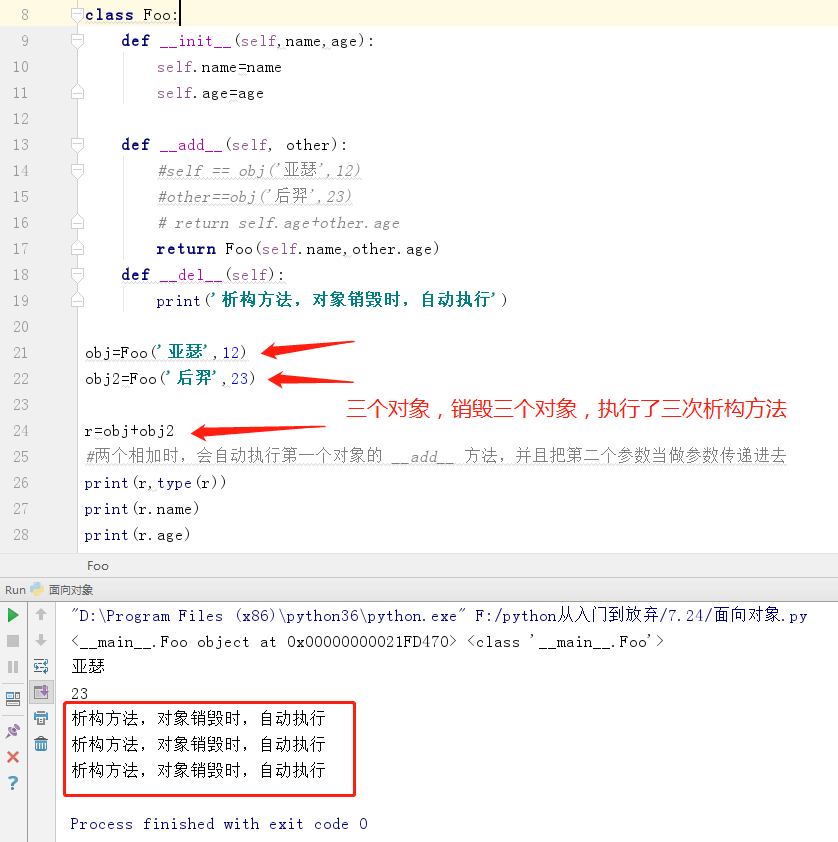
__dict__ #将对象中分装的所有成员,通过字典的形式,返回
1 class Foo: 2 def __init__(self,name,age): 3 self.name=name 4 self.age=age 5 6 def __add__(self, other): 7 #self == obj('亚瑟',12) 8 #other==obj('后羿',23) 9 # return self.age+other.age 10 return Foo(self.name,other.age) 11 def __del__(self): 12 print('析构方法,对象销毁时,自动执行') 13 14 15 obj=Foo('亚瑟',12) 16 d=obj.__dict__ 17 print(d)
运行结果:
"D:Program Files (x86)python36python.exe" F:/python从入门到放弃/7.24/面向对象.py {'name': '亚瑟', 'age': 12} 析构方法,对象销毁时,自动执行 Process finished with exit code 0
__doc__ 文档说明 表示类的描述信息
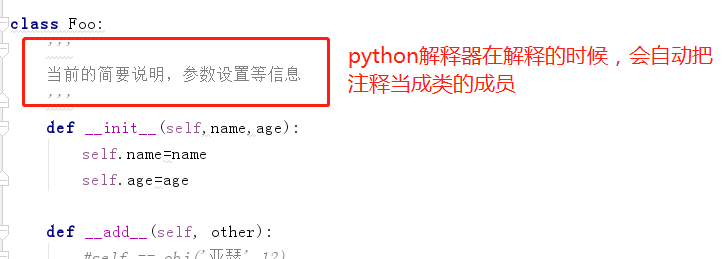

class Foo: """ 描述类信息,这是用于看片的神奇 """ def func(self): pass print Foo.__doc__ #输出:类的描述信息

1 class Foo: 2 ''' 3 当前的简要说明,参数设置等信息 4 ''' 5 def __init__(self,name,age): 6 self.name=name 7 self.age=age 8 9 def __add__(self, other): 10 #self == obj('亚瑟',12) 11 #other==obj('后羿',23) 12 # return self.age+other.age 13 return Foo(self.name,other.age) 14 def __del__(self): 15 print('析构方法,对象销毁时,自动执行') 16 17 # obj=Foo('亚瑟',12) 18 # d=obj.__dict__ 19 # print(d) 20 print(Foo.__dict__)

1 "D:Program Files (x86)python36python.exe" F:/python从入门到放弃/7.24/面向对象.py 2 {'__module__': '__main__', '__doc__': ' 当前的简要说明,参数设置等信息 ', '__init__': <function Foo.__init__ at 0x00000000021FD2F0>, '__add__': <function Foo.__add__ at 0x00000000021FD378>, '__del__': <function Foo.__del__ at 0x00000000021FD400>, '__dict__': <attribute '__dict__' of 'Foo' objects>, '__weakref__': <attribute '__weakref__' of 'Foo' objects>} 3 4 Process finished with exit code 0
__getitem__/__setitem__/__delitem__
1 class Foo: 2 def __init__(self,name,age): 3 self.name=name 4 self.age=age 5 def __getitem__(self, item): 6 return item+10 7 def __setitem__(self, key, value): 8 print(key,value) 9 def __delitem__(self, key): 10 print(key) 11 12 obj=Foo('亚瑟',12) 13 r=obj[8]#在对象后面后加上[] 以索引的方式访问,会自动执行 __getitem__方法 14 print(r) 15 16 obj[50]='得得得得得得'#通过索引赋值的访问,会自动执行 __setitem__ 方法 17 18 del obj[50]
运行结果:
"D:Program Files (x86)python36python.exe" F:/python从入门到放弃/7.24/面向对象.py 18 50 得得得得得得 50 Process finished with exit code 0
slice 切片类型的内部方法:
class slice(object): #............ start = property(lambda self: 0) """:type: int""" step = property(lambda self: 0) """:type: int""" stop = property(lambda self: 0) """:type: int""" __hash__ = None
__getitem__切片或是索引
1 class Foo: 2 def __init__(self,name,age): 3 self.name=name 4 self.age=age 5 def __getitem__(self, item): 6 print(item,type(item)) 7 # return item+10 8 if type(item)==slice: 9 print('切片处理') 10 print(item.start) 11 print(item.step) 12 print(item.stop) 13 else: 14 15 print("索引处理") 16 def __setitem__(self, key, value): 17 print(key,value) 18 def __delitem__(self, key): 19 print(key) 20 21 obj=Foo('亚瑟',12) 22 # r=obj[8]#在对象后面后加上[] 以索引的方式访问,会自动执行 __getitem__方法 23 # print(r) 24 # 25 # obj[50]='得得得得得得'#通过索引赋值的访问,会自动执行 __setitem__ 方法 26 # 27 # del obj[50] 28 obj[123] 29 obj[1:4:2]
运行结果:
"D:Program Files (x86)python36python.exe" F:/python从入门到放弃/7.24/面向对象.py 123 <class 'int'> 索引处理 slice(1, 4, 2) <class 'slice'> 切片处理 1 2 4
__iter__
#如果类中有__iter__方法,对象=》可迭代对象
#对象.__iter__()的返回值:迭代器
# for 循环,迭代器,next
# for循环,可迭代对象,对象.__iter__(),迭代器,next
#1、执行对象obj对应的类Foo中的 __iter__方法,并获取返回值
#2、循环返回中的对象
class Foo:
def __init__(self,name,age):
self.name=name
self.age=age
def __iter__(self):
return iter([11,22,33])
obj = Foo('亚瑟', 12)
#如果类中有__iter__方法,对象=》可迭代对象
#对象.__iter__()的返回值:迭代器
# for 循环,迭代器,next
# for循环,可迭代对象,对象.__iter__(),迭代器,next
#1、执行对象obj对应的类Foo中的 __iter__方法,并获取返回值
#2、循环返回中的对象
for i in obj:
print(i)
For循环语法内部
#!/usr/bin/env python # -*- coding:utf-8 -*- obj = iter([11,22,33,44]) while True: val = obj.next() print val
__module__ 和 __class__
__module__ 表示当前操作的对象在那个模块
__class__ 表示当前操作的对象的类是什么

1 #!/usr/bin/env python 2 # -*- coding:utf-8 -*- 3 4 class C: 5 6 def __init__(self): 7 pass
1 from lib.aa import C 2 3 obj = C() 4 print obj.__module__ # 输出 lib.aa,即:输出模块 5 print obj.__class__ # 输出 lib.aa.C,即:输出类
__getslice__、__setslice__、__delslice__
该三个方法用于分片操作,如:列表
#!/usr/bin/env python # -*- coding:utf-8 -*- class Foo(object): def __getslice__(self, i, j): print '__getslice__',i,j def __setslice__(self, i, j, sequence): print '__setslice__',i,j def __delslice__(self, i, j): print '__delslice__',i,j obj = Foo() obj[-1:1] # 自动触发执行 __getslice__ obj[0:1] = [11,22,33,44] # 自动触发执行 __setslice__ del obj[0:2] # 自动触发执行 __delslice__
__new__ 和 __metaclass__
1 class Foo(object): 2 3 def __init__(self): 4 pass 5 6 obj = Foo() # obj是通过Foo类实例化的对象
上述代码中,obj 是通过 Foo 类实例化的对象,其实,不仅 obj 是一个对象,Foo类本身也是一个对象,因为在Python中一切事物都是对象。
如果按照一切事物都是对象的理论:obj对象是通过执行Foo类的构造方法创建,那么Foo类对象应该也是通过执行某个类的 构造方法 创建。
print type(obj) # 输出:<class '__main__.Foo'> 表示,obj 对象由Foo类创建 print type(Foo) # 输出:<type 'type'> 表示,Foo类对象由 type 类创建
所以,obj对象是Foo类的一个实例,Foo类对象是 type 类的一个实例,即:Foo类对象 是通过type类的构造方法创建。
那么,创建类就可以有两种方式:
a). 普通方式
class Foo(object):
def func(self):
print ('hello world')
b).特殊方式(type类的构造函数)
def func(self): print ('hello world') Foo = type('Foo',(object,), {'func': func}) #type第一个参数:类名 #type第二个参数:当前类的基类 #type第三个参数:类的成员
==》 类 是由 type 类实例化产生
那么问题来了,类默认是由 type 类实例化产生,type类中如何实现的创建类?类又是如何创建对象?
答:类中有一个属性 __metaclass__,其用来表示该类由 谁 来实例化创建,所以,我们可以为 __metaclass__ 设置一个type类的派生类,从而查看 类 创建的过程。
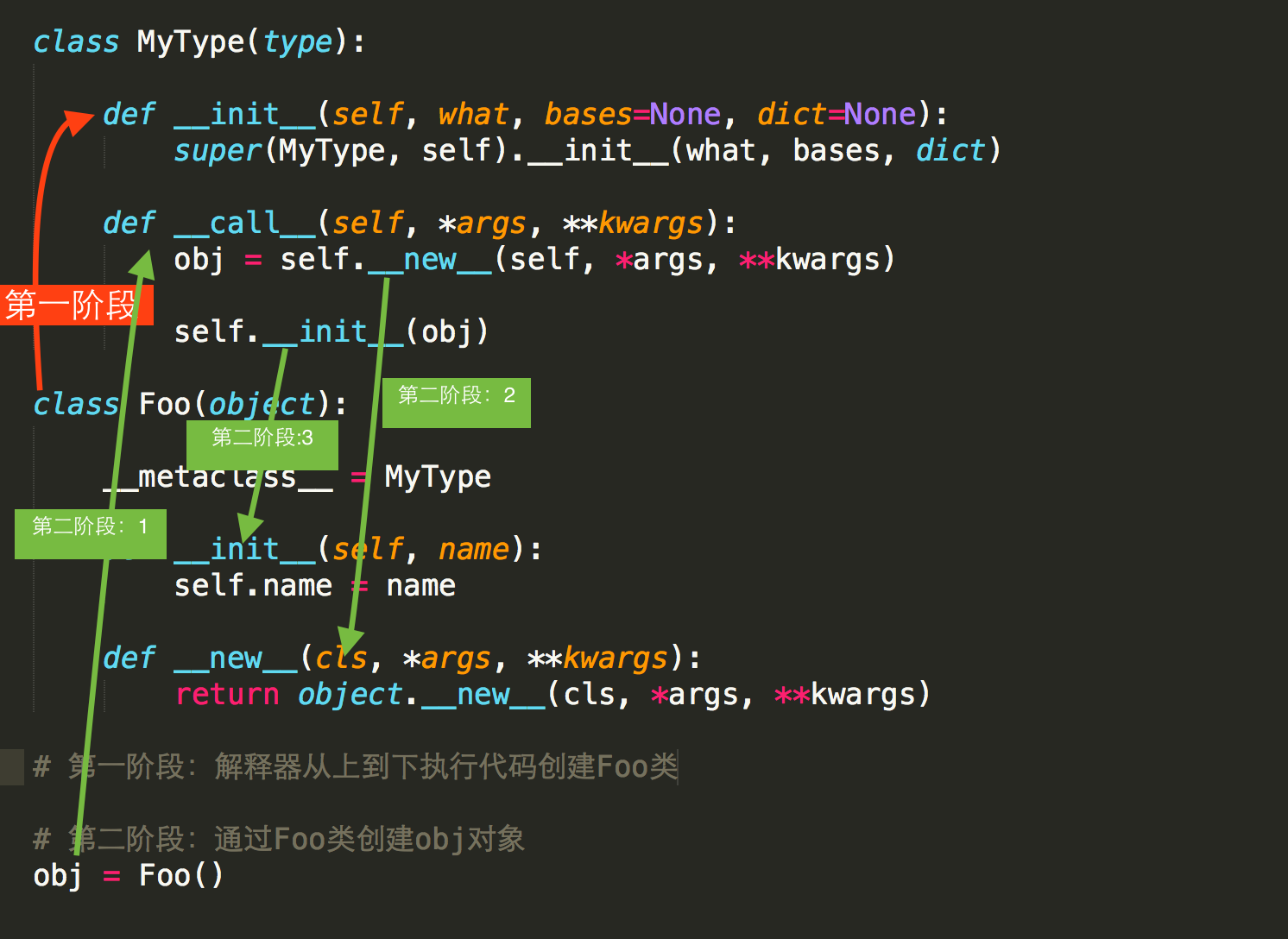

1 class MyType(type): 2 3 def __init__(self, what, bases=None, dict=None): 4 super(MyType, self).__init__(what, bases, dict) 5 6 def __call__(self, *args, **kwargs): 7 obj = self.__new__(self, *args, **kwargs) 8 9 self.__init__(obj) 10 11 class Foo(object): 12 13 __metaclass__ = MyType 14 15 def __init__(self, name): 16 self.name = name 17 18 def __new__(cls, *args, **kwargs): 19 return object.__new__(cls, *args, **kwargs) 20 21 # 第一阶段:解释器从上到下执行代码创建Foo类 22 # 第二阶段:通过Foo类创建obj对象 23 obj = Foo()
万物皆对象
__metaclass__ 类的祖宗
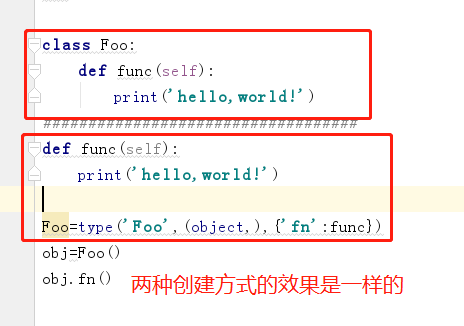

1 # class Foo: 2 # def func(self): 3 # print('hello,world!') 4 ################################### 5 def func(self): 6 print('hello,world!') 7 Foo=type('Foo',(object,),{'fn':func}) 8 # obj=Foo() 9 # obj.fn()
1 class MyType(type): 2 def __init__(self,*args,**kwargs): 3 print('如果创建类会继承type的话,那么类Foo一被创建,就会执行这句') 4 def __call__(self, *args, **kwargs): 5 print('234') 6 r=self.__new__() 7 8 #原先,当我们创建类 Foo 的时候,会默认调用type 9 #现在,当我们想要让Foo在创建的时候,调用MyType 10 # 11 class Foo(object,metaclass=MyType): 12 def __init__(self): 13 pass 14 def __new__(cls, *args, **kwargs): 15 return "duxiiang" 16 17 def func(self): 18 print('hello,world!') 19 20 obj=Foo() 21 ''' 22 Foo=MyType('Foo',(object,),{'fn':func}) 23 1、由于Foo 是 MyType的对象,所以,Foo()执行MyType的__call__方法 24 2、MyType的__call__方法调用Foo类的__new__方法创建对象obj,并把对象返回 25 3、返回的值,调用Foo类的__init__方法 26 27 所以表面上看到,当创建obj时,会调用Foo类的__init__方法 28 '''

1 #!/usr/bin/env python3 2 #-*- coding:utf-8 -*- 3 ''' 4 Administrator 5 2018/7/24 6 ''' 7 class MyType(type): 8 def __init__(self,*args,**kwargs): 9 print('如果创建类会继承type的话,那么类Foo一被创建,就会执行这句') 10 def __call__(self, *args, **kwargs): 11 print('234') 12 r=self.__new__() 13 14 #原先,当我们创建类 Foo 的时候,会默认调用type 15 #现在,当我们想要让Foo在创建的时候,调用MyType 16 # 17 class Foo(object,metaclass=MyType): 18 def __init__(self): 19 pass 20 def __new__(cls, *args, **kwargs): 21 return "duxiiang" 22 23 def func(self): 24 print('hello,world!') 25 26 obj=Foo() 27 ''' 28 Foo=MyType('Foo',(object,),{'fn':func}) 29 1、由于Foo 是 MyType的对象,所以,Foo()执行MyType的__call__方法 30 2、MyType的__call__方法调用Foo类的__new__方法创建对象obj,并把对象返回 31 3、返回的值,调用Foo类的__init__方法 32 33 所以表面上看到,当创建obj时,会调用Foo类的__init__方法 34 ''' 35 36 37 38 ################################### 39 # def func(self): 40 # print('hello,world!') 41 # Foo=type('Foo',(object,),{'fn':func}) 42 # obj=Foo() 43 # obj.fn() 44 45 46 47 48 49 50 51 # class Foo: 52 # def __init__(self,name,age): 53 # self.name=name 54 # self.age=age 55 # def __iter__(self): 56 # return iter([11,22,33]) 57 # 58 # 59 # obj = Foo('亚瑟', 12) 60 # #如果类中有__iter__方法,对象=》可迭代对象 61 # #对象.__iter__()的返回值:迭代器 62 # # for 循环,迭代器,next 63 # # for循环,可迭代对象,对象.__iter__(),迭代器,next 64 # #1、执行对象obj对应的类Foo中的 __iter__方法,并获取返回值 65 # #2、循环返回中的对象 66 # for i in obj: 67 # print(i) 68 69 70 71 # li=list([1,2,3,6,5,7,8]) 72 # r1=li[3] 73 # print(r1) 74 75 76 # class Foo: 77 # def __init__(self,name,age): 78 # self.name=name 79 # self.age=age 80 # def __getitem__(self, item): 81 # print(item,type(item)) 82 # # return item+10 83 # if type(item)==slice: 84 # print('切片处理') 85 # print(item.start) 86 # print(item.step) 87 # print(item.stop) 88 # else: 89 # 90 # print("索引处理") 91 # def __setitem__(self, key, value): 92 # print(key,value) 93 # def __delitem__(self, key): 94 # print(key) 95 # 96 # obj=Foo('亚瑟',12) 97 # r=obj[8]#在对象后面后加上[] 以索引的方式访问,会自动执行 __getitem__方法 98 # print(r) 99 # 100 # obj[50]='得得得得得得'#通过索引赋值的访问,会自动执行 __setitem__ 方法 101 # 102 # del obj[50] 103 # obj[123] 104 # obj[1:4:2] 105 106 107 108 # class Foo: 109 # ''' 110 # 当前的简要说明,参数设置等信息 111 # ''' 112 # def __init__(self,name,age): 113 # self.name=name 114 # self.age=age 115 # 116 # def __add__(self, other): 117 # #self == obj('亚瑟',12) 118 # #other==obj('后羿',23) 119 # # return self.age+other.age 120 # return Foo(self.name,other.age) 121 # def __del__(self): 122 # print('析构方法,对象销毁时,自动执行') 123 124 # obj=Foo('亚瑟',12) 125 # d=obj.__dict__ 126 # print(d) 127 # print(Foo.__dict__) 128 129 # obj2=Foo('后羿',23) 130 # 131 # r=obj+obj2 132 # #两个相加时,会自动执行第一个对象的 __add__ 方法,并且把第二个参数当做参数传递进去 133 # print(r,type(r)) 134 # print(r.name) 135 # print(r.age) 136 137 138 # class Foo: 139 # def __init__(self,name,age): 140 # self.name=name 141 # self.age=age 142 # 143 # def __str__(self): #用于打印 144 # return '%s----%s'%(self.name,self.age) 145 # 146 # obj=Foo('Jach',12) 147 # #如果直接调用对象打印出来,会默认直接调用 __str__ 方法 148 # #内部先把'print(obj)'默认转换成>>>'print(str(obj))' 并且打印出来 149 # print(obj) 150 151 152 153 # s="123" 154 # # s1=str('123') 155 # i=int(s) 156 # print(i,type(i)) 157 ############################## 158 # class Foo: 159 # def __init__(self): 160 # pass 161 # def __int__(self): 162 # return 111 163 # def __str__(self): 164 # return 'string' 165 # obj=Foo() 166 # 167 # print(obj,' ',type(obj)) 168 # 169 # #int ,对象,自动执行对象的__int__ 方法,并将返回值赋值给int对象 170 # r=int(obj) 171 # print(r) 172 # #str ,对象,自动执行对象的__str__ 方法,并将返回值赋值给str对象 173 # t=str(obj) 174 # print(t) 175 176 177 178 # class Foo: 179 # def __init__(self): #对象后面加上() 自动执行 init 方法 180 # print('init') 181 # 182 # 183 # def __call__(self, *args, **kwargs): ##对象后面加() 自动执行 call 方法 184 # print('call') 185 # 186 # 187 # # obj=Foo() 188 # # obj() 189 # Foo()() 190 191 192 193 # class ClassFather: 194 # def __init__(self): 195 # self.__age=23 196 # self.score=90 197 # 198 # class ClassSon(ClassFather): 199 # def __init__(self,name): 200 # self.name=name 201 # self.__gender='男' 202 # super().__init__() 203 # 204 # def show(self): 205 # print(self.name) 206 # print(self.__gender) 207 # print(self.score) 208 # #print(self.__age)#私有字段只能在类的内部使用,不能被继承 209 # 210 # s=ClassSon('李逵') 211 # s.show() 212 213 # #案例 数据库账户 214 # class Database: 215 # __root="root" 216 # __pwd='abc123' 217 # __port='3306' 218 # __dbname='ssoa' 219 # # def __init__(self,pwd): 220 # # pass 221 # ###############只读模式######################## 222 # def get_root(self): #只能访问,不能修改 可读 223 # return self.__root 224 # def get_port(self): 225 # return self.__port 226 # 227 # ###########读写模式 ################# 228 # def get_pwd(self): #获取密码 229 # return self.__pwd 230 # def set_pwd(self,pwd): #修改密码 231 # self.__pwd = pwd 232 # 233 # db= Database() 234 # print(db.get_pwd()) #调用密码 235 # db.set_pwd('456') #修改密码 236 # print(db.get_pwd())#调用密码 237 238 239 240 241 242 243 # class Foo: 244 # 245 # def gender(self): 246 # return '女' 247 # obj=Foo() 248 # print(obj.gender()) 249 ##################################### 250 # class Foo: 251 # 252 # def __gender(self): 253 # return '女' 254 # def get_gender(self): 255 # r=self.__gender() 256 # return r 257 # obj=Foo() 258 # print(obj.get_gender()) 259 260 261 262 # class Foo: 263 # __gender='男' 264 # def __init__(self): 265 # pass 266 # 267 # def get_gender(self): 268 # return Foo.__gender 269 # 270 # # @staticmethod 271 # # def get_gender(): 272 # # return Foo.__gender 273 # # obj=Foo() 274 # # print(obj.get_gender()) 275 # print(Foo.get_gender()) 276 277 278 279 280 281 282 #成员修饰符 修饰符可以规定内部的字段、属性、方法等 是共有的成员,私有的成员 283 # class Foo: 284 # #gender='男' #对于静态字段 285 # __gender = '男' 286 # def __init__(self,name,age): 287 # self.name=name 288 # #self.age=age #对于普通字段可以在外部直接访问 289 # self.__age=age #添加 __ 两个下划线,就变成私有字段,外部不能访问 290 # def get_age(self): 291 # return self.__age 292 # @staticmethod 293 # def get_gender(self): 294 # return Foo.__gender 295 # obj=Foo('Jack',22) 296 # # print(obj.name) 297 # # print(obj.get_age()) 298 # print(Foo.get_gender()) 299 300 301 302 # class Foo: 303 # def __init__(self): 304 # self.list_name=['tom'] 305 # def bar(self): #普通方法需要创建对象,通过对象调用 306 # print('bar') 307 # @staticmethod 308 # def sta():#不需要参数,普通方法,保存在类中,通过对象调用 309 # print('123') 310 # @staticmethod#静态方法,可以不用调用对象,保存在类中,直接调用 311 # def sts(a,b): 312 # print(a,b) 313 # @classmethod 314 # def classmd(cls):#类方法必须有一个参数,保存在类中,直接调用 315 # print(cls) 316 # #cls 类名 317 # print('classmd') 318 # @property 319 # def per(self): #定义像方法,访问像字段。可以有返回值。 叫属性或者特性 320 # del self.list_name[0] 321 # print(self.list_name) 322 # @per.setter 323 # def per(self,val): 324 # print(val) 325 # @per.deleter 326 # def per(self): 327 # return 'ok' 328 # # Foo.sta() 329 # Foo.sts(3,6) 330 # Foo.classmd() 331 # obj=Foo() 332 # obj.per 333 # obj.per=456 334 # del obj.per 335 336 337 338 # class Foo: 339 # def f1(self): 340 # print('123') 341 # return 123 342 # def f2(self,val): 343 # print(val) 344 # def f3(self): 345 # print('ok') 346 # per=property(fget=f1,fset=f2,fdel=f3) 347 # ######等价于################# 348 # # @property 349 # # def per(self): 350 # # return 123 351 # obj=Foo() 352 # # obj.per=456 353 # del obj.per 354 355 356 357 358 # class Province: 359 # country='中国' #静态字段,属于类 360 # def __init__(self,name): 361 # self.name=name #这个是普通字段,属于对象 362 # 363 # 364 # print(Province.country) 365 # jiangsu=Province('江苏') 366 # print(jiangsu.country)
